Business Model Analysis Report: Direct Marketing Efficiencies
VerifiedAdded on 2023/02/01
|16
|2525
|92
Report
AI Summary
This report provides a comprehensive analysis of a business model, with a focus on integrating traditional direct marketing practices with the cost and distributional efficiencies offered by the internet. The report begins with an executive summary outlining the core objectives of the analysis, which include the development of a business model canvas to facilitate business growth. It delves into the various building blocks of the business model canvas, such as customer segments, key partners, value propositions, channels, revenue streams, cost structures, key resources, and customer relationships. The report explores the interrelationships between these building blocks and identifies critical success factors for the model's implementation. It also assesses potential risks associated with the business model and offers recommendations for improvement, including adjustments to revenue streams and customer segmentation. The analysis draws on various sources and provides tables to illustrate key aspects such as customer segmentation, key partners, channels, and revenue streams. The report concludes with a summary of the key findings and recommendations, emphasizing the importance of customer relationships and technological advancements in achieving business success. The report aims to provide a practical guide for businesses seeking to leverage both traditional and digital marketing strategies.

Running head: MANAGEMENT
Management
Name of the student
Name of the university
Author Note
Management
Name of the student
Name of the university
Author Note
Paraphrase This Document
Need a fresh take? Get an instant paraphrase of this document with our AI Paraphraser
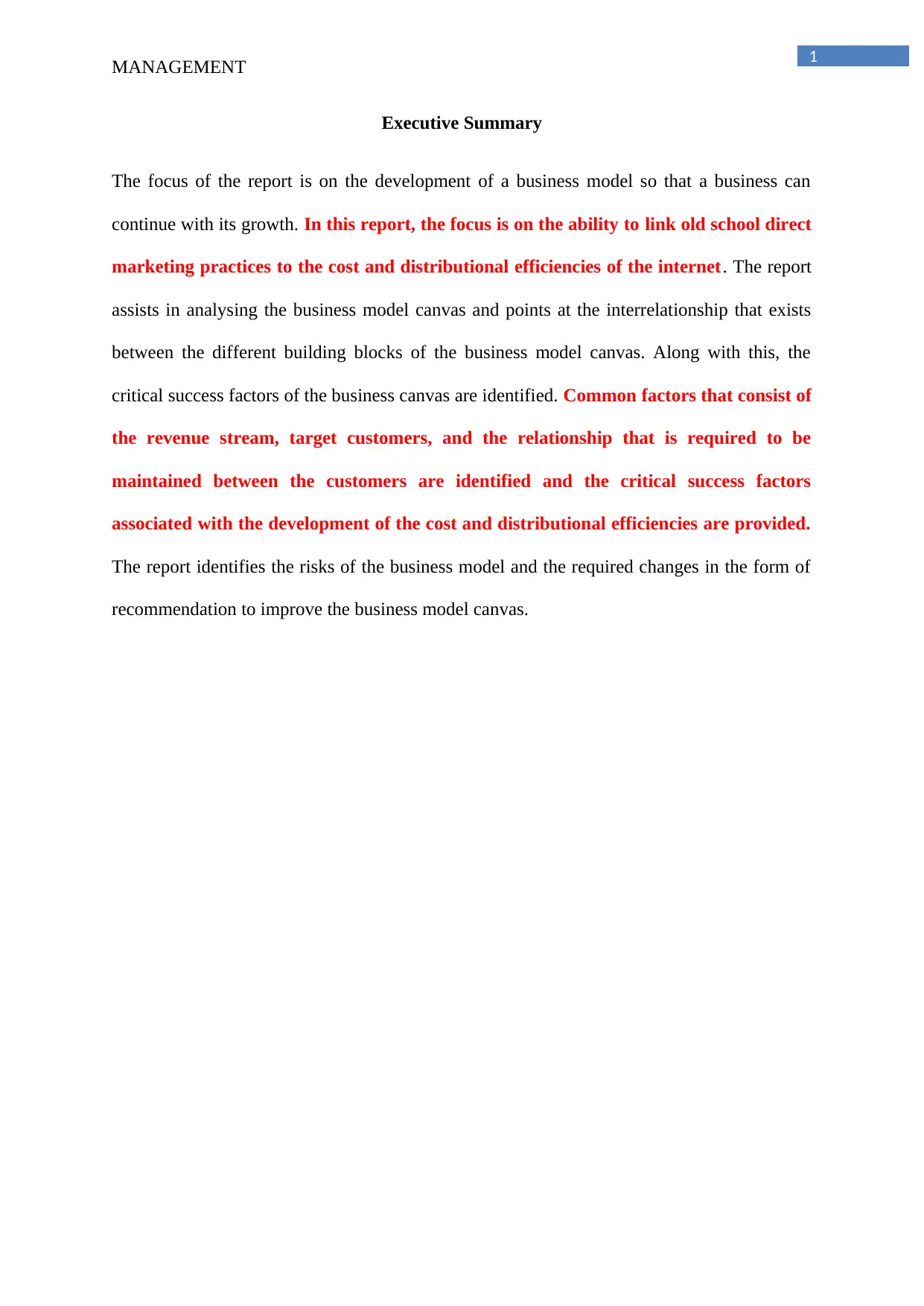
1
MANAGEMENT
Executive Summary
The focus of the report is on the development of a business model so that a business can
continue with its growth. In this report, the focus is on the ability to link old school direct
marketing practices to the cost and distributional efficiencies of the internet. The report
assists in analysing the business model canvas and points at the interrelationship that exists
between the different building blocks of the business model canvas. Along with this, the
critical success factors of the business canvas are identified. Common factors that consist of
the revenue stream, target customers, and the relationship that is required to be
maintained between the customers are identified and the critical success factors
associated with the development of the cost and distributional efficiencies are provided.
The report identifies the risks of the business model and the required changes in the form of
recommendation to improve the business model canvas.
MANAGEMENT
Executive Summary
The focus of the report is on the development of a business model so that a business can
continue with its growth. In this report, the focus is on the ability to link old school direct
marketing practices to the cost and distributional efficiencies of the internet. The report
assists in analysing the business model canvas and points at the interrelationship that exists
between the different building blocks of the business model canvas. Along with this, the
critical success factors of the business canvas are identified. Common factors that consist of
the revenue stream, target customers, and the relationship that is required to be
maintained between the customers are identified and the critical success factors
associated with the development of the cost and distributional efficiencies are provided.
The report identifies the risks of the business model and the required changes in the form of
recommendation to improve the business model canvas.
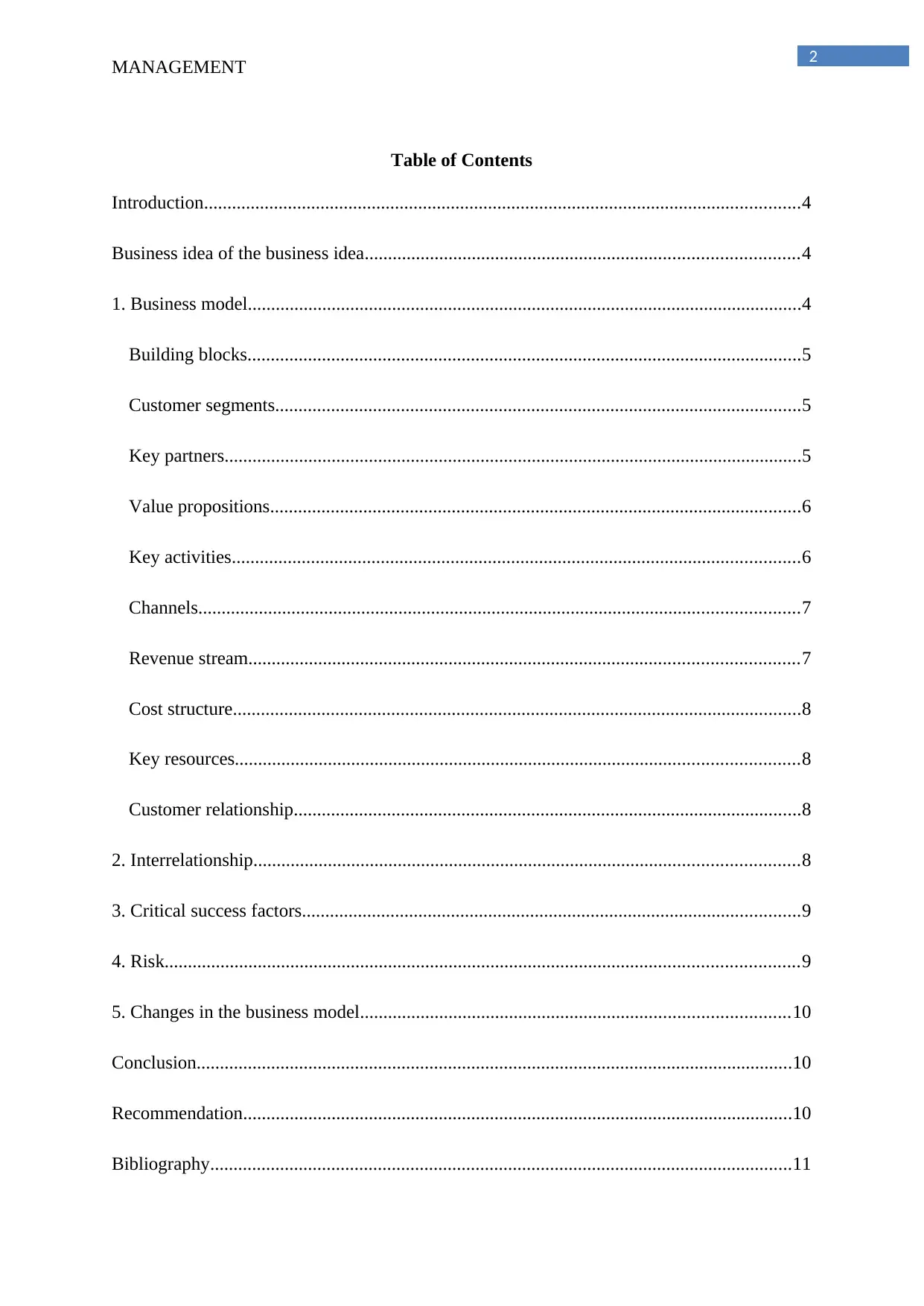
2
MANAGEMENT
Table of Contents
Introduction................................................................................................................................4
Business idea of the business idea.............................................................................................4
1. Business model.......................................................................................................................4
Building blocks.......................................................................................................................5
Customer segments.................................................................................................................5
Key partners............................................................................................................................5
Value propositions..................................................................................................................6
Key activities..........................................................................................................................6
Channels.................................................................................................................................7
Revenue stream......................................................................................................................7
Cost structure..........................................................................................................................8
Key resources.........................................................................................................................8
Customer relationship.............................................................................................................8
2. Interrelationship.....................................................................................................................8
3. Critical success factors...........................................................................................................9
4. Risk........................................................................................................................................9
5. Changes in the business model............................................................................................10
Conclusion................................................................................................................................10
Recommendation......................................................................................................................10
Bibliography.............................................................................................................................11
MANAGEMENT
Table of Contents
Introduction................................................................................................................................4
Business idea of the business idea.............................................................................................4
1. Business model.......................................................................................................................4
Building blocks.......................................................................................................................5
Customer segments.................................................................................................................5
Key partners............................................................................................................................5
Value propositions..................................................................................................................6
Key activities..........................................................................................................................6
Channels.................................................................................................................................7
Revenue stream......................................................................................................................7
Cost structure..........................................................................................................................8
Key resources.........................................................................................................................8
Customer relationship.............................................................................................................8
2. Interrelationship.....................................................................................................................8
3. Critical success factors...........................................................................................................9
4. Risk........................................................................................................................................9
5. Changes in the business model............................................................................................10
Conclusion................................................................................................................................10
Recommendation......................................................................................................................10
Bibliography.............................................................................................................................11
⊘ This is a preview!⊘
Do you want full access?
Subscribe today to unlock all pages.

Trusted by 1+ million students worldwide

3
MANAGEMENT
Appendices...............................................................................................................................13
Appendix..............................................................................................................................13
MANAGEMENT
Appendices...............................................................................................................................13
Appendix..............................................................................................................................13
Paraphrase This Document
Need a fresh take? Get an instant paraphrase of this document with our AI Paraphraser
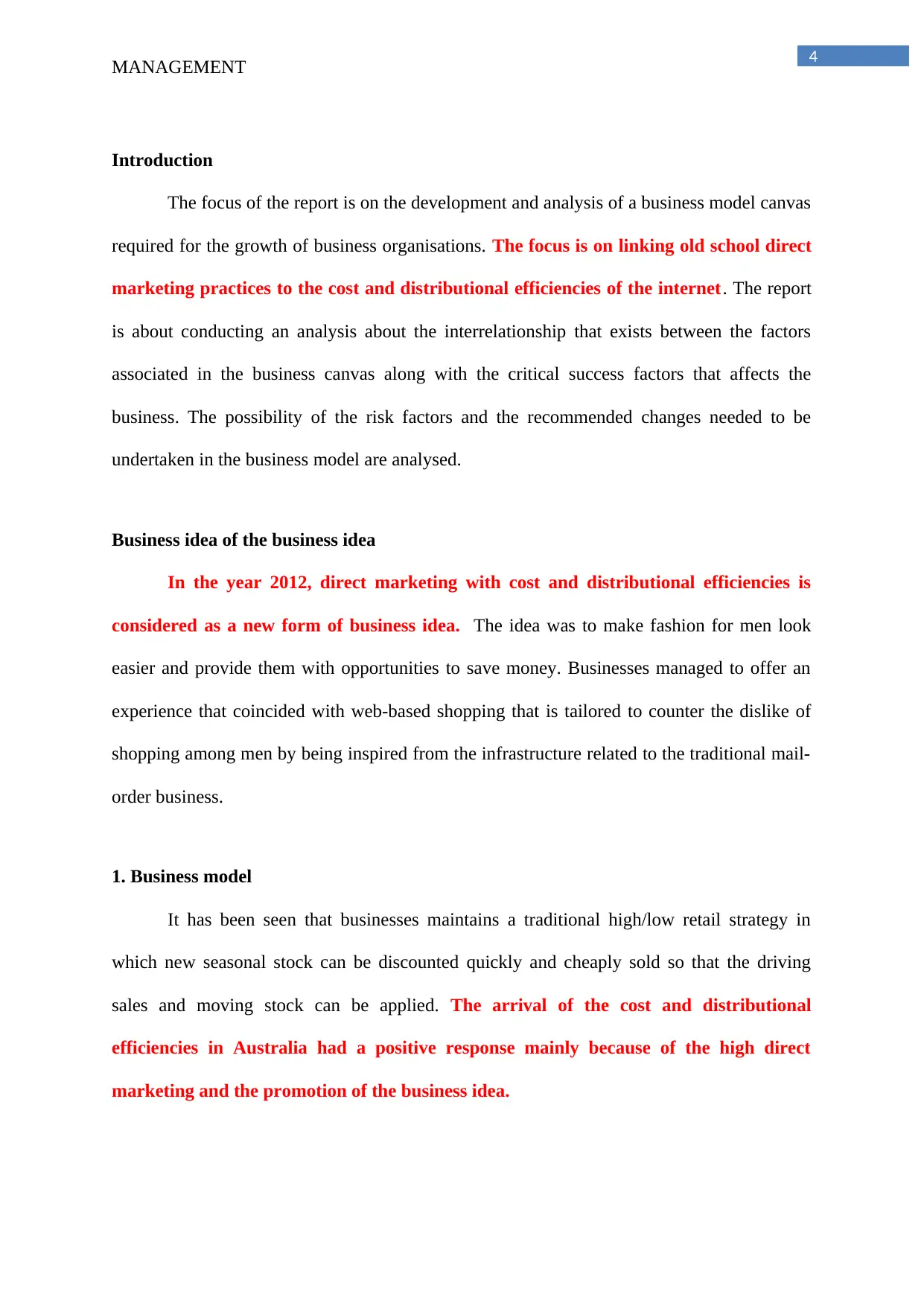
4
MANAGEMENT
Introduction
The focus of the report is on the development and analysis of a business model canvas
required for the growth of business organisations. The focus is on linking old school direct
marketing practices to the cost and distributional efficiencies of the internet. The report
is about conducting an analysis about the interrelationship that exists between the factors
associated in the business canvas along with the critical success factors that affects the
business. The possibility of the risk factors and the recommended changes needed to be
undertaken in the business model are analysed.
Business idea of the business idea
In the year 2012, direct marketing with cost and distributional efficiencies is
considered as a new form of business idea. The idea was to make fashion for men look
easier and provide them with opportunities to save money. Businesses managed to offer an
experience that coincided with web-based shopping that is tailored to counter the dislike of
shopping among men by being inspired from the infrastructure related to the traditional mail-
order business.
1. Business model
It has been seen that businesses maintains a traditional high/low retail strategy in
which new seasonal stock can be discounted quickly and cheaply sold so that the driving
sales and moving stock can be applied. The arrival of the cost and distributional
efficiencies in Australia had a positive response mainly because of the high direct
marketing and the promotion of the business idea.
MANAGEMENT
Introduction
The focus of the report is on the development and analysis of a business model canvas
required for the growth of business organisations. The focus is on linking old school direct
marketing practices to the cost and distributional efficiencies of the internet. The report
is about conducting an analysis about the interrelationship that exists between the factors
associated in the business canvas along with the critical success factors that affects the
business. The possibility of the risk factors and the recommended changes needed to be
undertaken in the business model are analysed.
Business idea of the business idea
In the year 2012, direct marketing with cost and distributional efficiencies is
considered as a new form of business idea. The idea was to make fashion for men look
easier and provide them with opportunities to save money. Businesses managed to offer an
experience that coincided with web-based shopping that is tailored to counter the dislike of
shopping among men by being inspired from the infrastructure related to the traditional mail-
order business.
1. Business model
It has been seen that businesses maintains a traditional high/low retail strategy in
which new seasonal stock can be discounted quickly and cheaply sold so that the driving
sales and moving stock can be applied. The arrival of the cost and distributional
efficiencies in Australia had a positive response mainly because of the high direct
marketing and the promotion of the business idea.
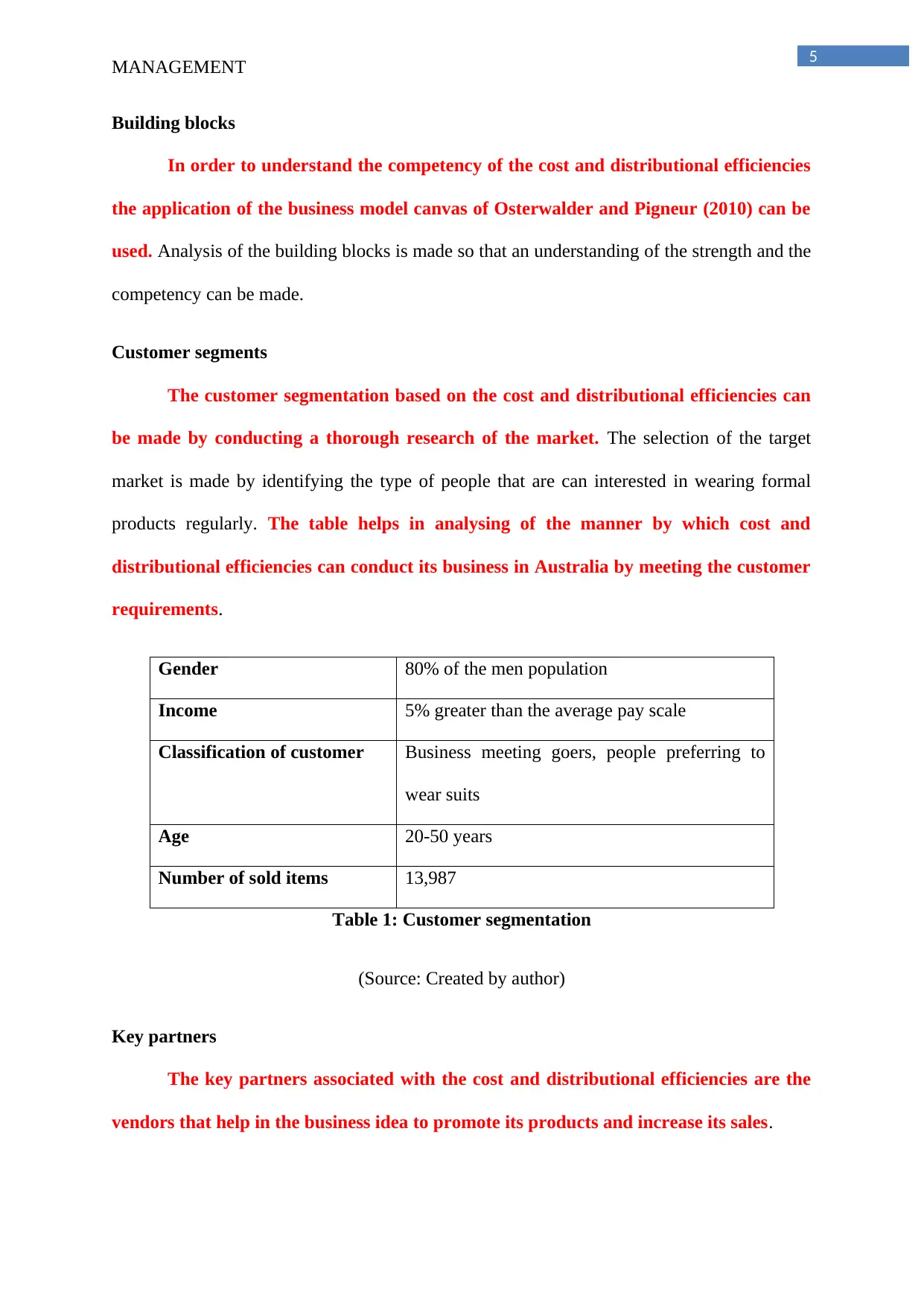
5
MANAGEMENT
Building blocks
In order to understand the competency of the cost and distributional efficiencies
the application of the business model canvas of Osterwalder and Pigneur (2010) can be
used. Analysis of the building blocks is made so that an understanding of the strength and the
competency can be made.
Customer segments
The customer segmentation based on the cost and distributional efficiencies can
be made by conducting a thorough research of the market. The selection of the target
market is made by identifying the type of people that are can interested in wearing formal
products regularly. The table helps in analysing of the manner by which cost and
distributional efficiencies can conduct its business in Australia by meeting the customer
requirements.
Gender 80% of the men population
Income 5% greater than the average pay scale
Classification of customer Business meeting goers, people preferring to
wear suits
Age 20-50 years
Number of sold items 13,987
Table 1: Customer segmentation
(Source: Created by author)
Key partners
The key partners associated with the cost and distributional efficiencies are the
vendors that help in the business idea to promote its products and increase its sales.
MANAGEMENT
Building blocks
In order to understand the competency of the cost and distributional efficiencies
the application of the business model canvas of Osterwalder and Pigneur (2010) can be
used. Analysis of the building blocks is made so that an understanding of the strength and the
competency can be made.
Customer segments
The customer segmentation based on the cost and distributional efficiencies can
be made by conducting a thorough research of the market. The selection of the target
market is made by identifying the type of people that are can interested in wearing formal
products regularly. The table helps in analysing of the manner by which cost and
distributional efficiencies can conduct its business in Australia by meeting the customer
requirements.
Gender 80% of the men population
Income 5% greater than the average pay scale
Classification of customer Business meeting goers, people preferring to
wear suits
Age 20-50 years
Number of sold items 13,987
Table 1: Customer segmentation
(Source: Created by author)
Key partners
The key partners associated with the cost and distributional efficiencies are the
vendors that help in the business idea to promote its products and increase its sales.
⊘ This is a preview!⊘
Do you want full access?
Subscribe today to unlock all pages.

Trusted by 1+ million students worldwide
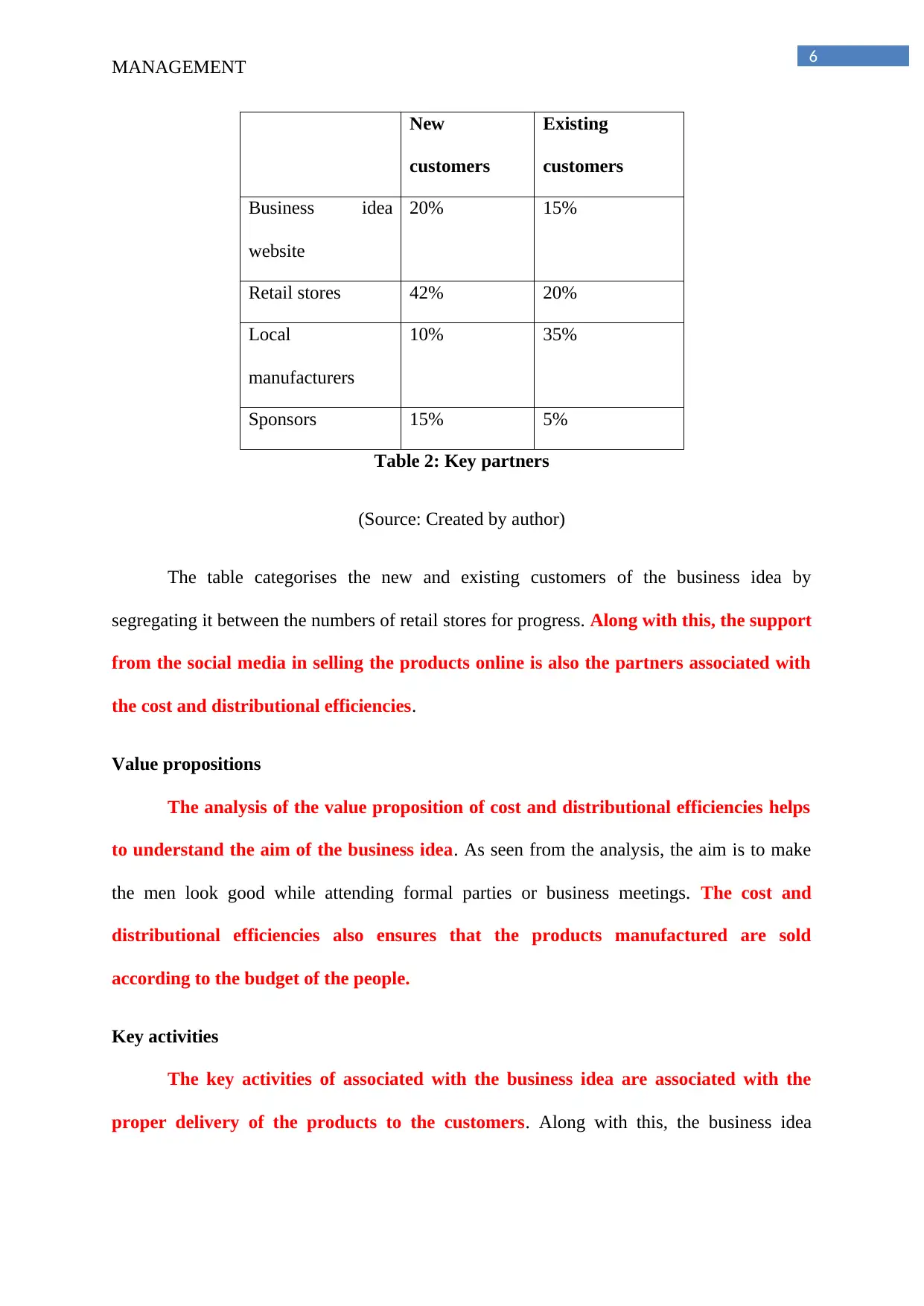
6
MANAGEMENT
New
customers
Existing
customers
Business idea
website
20% 15%
Retail stores 42% 20%
Local
manufacturers
10% 35%
Sponsors 15% 5%
Table 2: Key partners
(Source: Created by author)
The table categorises the new and existing customers of the business idea by
segregating it between the numbers of retail stores for progress. Along with this, the support
from the social media in selling the products online is also the partners associated with
the cost and distributional efficiencies.
Value propositions
The analysis of the value proposition of cost and distributional efficiencies helps
to understand the aim of the business idea. As seen from the analysis, the aim is to make
the men look good while attending formal parties or business meetings. The cost and
distributional efficiencies also ensures that the products manufactured are sold
according to the budget of the people.
Key activities
The key activities of associated with the business idea are associated with the
proper delivery of the products to the customers. Along with this, the business idea
MANAGEMENT
New
customers
Existing
customers
Business idea
website
20% 15%
Retail stores 42% 20%
Local
manufacturers
10% 35%
Sponsors 15% 5%
Table 2: Key partners
(Source: Created by author)
The table categorises the new and existing customers of the business idea by
segregating it between the numbers of retail stores for progress. Along with this, the support
from the social media in selling the products online is also the partners associated with
the cost and distributional efficiencies.
Value propositions
The analysis of the value proposition of cost and distributional efficiencies helps
to understand the aim of the business idea. As seen from the analysis, the aim is to make
the men look good while attending formal parties or business meetings. The cost and
distributional efficiencies also ensures that the products manufactured are sold
according to the budget of the people.
Key activities
The key activities of associated with the business idea are associated with the
proper delivery of the products to the customers. Along with this, the business idea
Paraphrase This Document
Need a fresh take? Get an instant paraphrase of this document with our AI Paraphraser
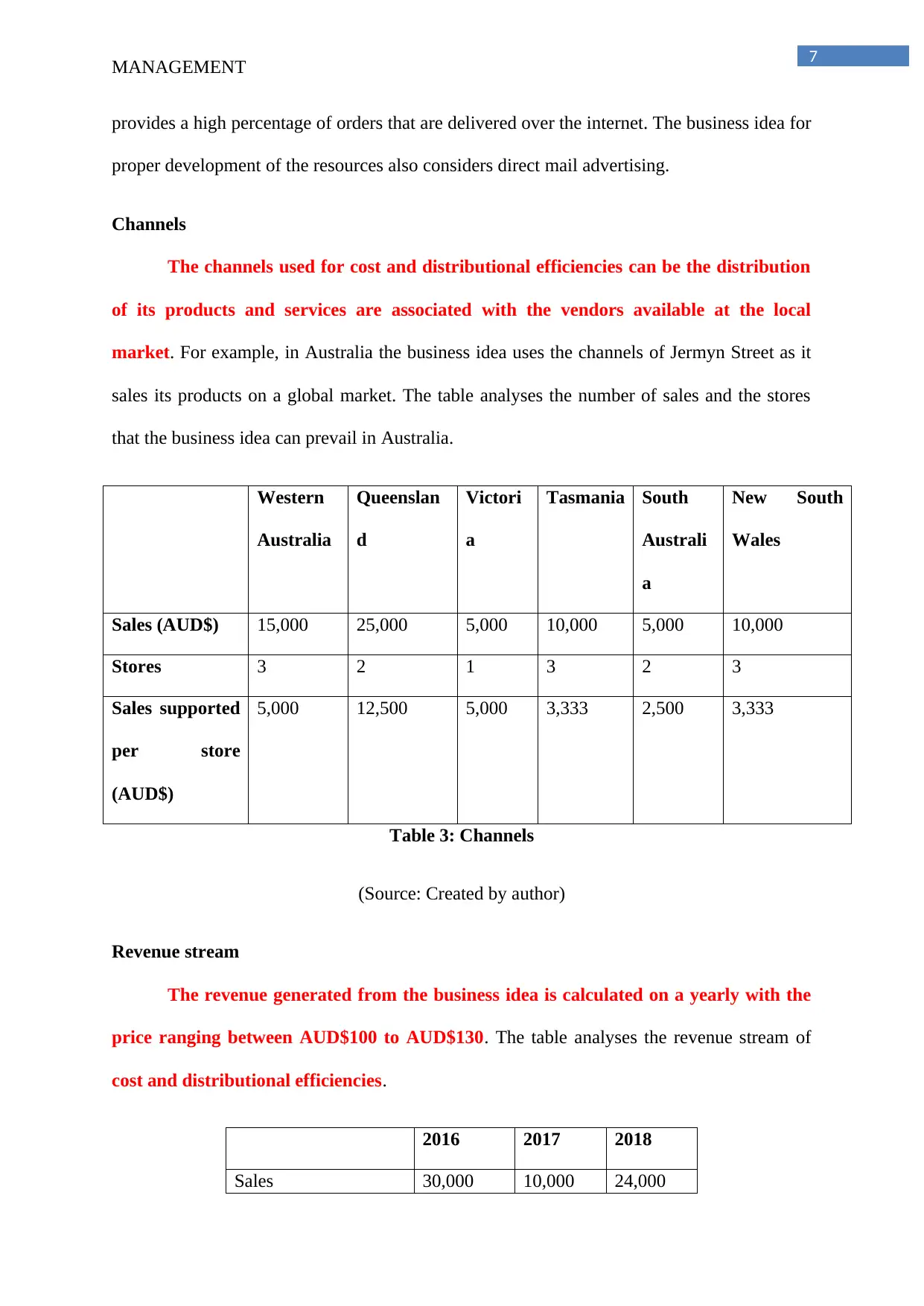
7
MANAGEMENT
provides a high percentage of orders that are delivered over the internet. The business idea for
proper development of the resources also considers direct mail advertising.
Channels
The channels used for cost and distributional efficiencies can be the distribution
of its products and services are associated with the vendors available at the local
market. For example, in Australia the business idea uses the channels of Jermyn Street as it
sales its products on a global market. The table analyses the number of sales and the stores
that the business idea can prevail in Australia.
Western
Australia
Queenslan
d
Victori
a
Tasmania South
Australi
a
New South
Wales
Sales (AUD$) 15,000 25,000 5,000 10,000 5,000 10,000
Stores 3 2 1 3 2 3
Sales supported
per store
(AUD$)
5,000 12,500 5,000 3,333 2,500 3,333
Table 3: Channels
(Source: Created by author)
Revenue stream
The revenue generated from the business idea is calculated on a yearly with the
price ranging between AUD$100 to AUD$130. The table analyses the revenue stream of
cost and distributional efficiencies.
2016 2017 2018
Sales 30,000 10,000 24,000
MANAGEMENT
provides a high percentage of orders that are delivered over the internet. The business idea for
proper development of the resources also considers direct mail advertising.
Channels
The channels used for cost and distributional efficiencies can be the distribution
of its products and services are associated with the vendors available at the local
market. For example, in Australia the business idea uses the channels of Jermyn Street as it
sales its products on a global market. The table analyses the number of sales and the stores
that the business idea can prevail in Australia.
Western
Australia
Queenslan
d
Victori
a
Tasmania South
Australi
a
New South
Wales
Sales (AUD$) 15,000 25,000 5,000 10,000 5,000 10,000
Stores 3 2 1 3 2 3
Sales supported
per store
(AUD$)
5,000 12,500 5,000 3,333 2,500 3,333
Table 3: Channels
(Source: Created by author)
Revenue stream
The revenue generated from the business idea is calculated on a yearly with the
price ranging between AUD$100 to AUD$130. The table analyses the revenue stream of
cost and distributional efficiencies.
2016 2017 2018
Sales 30,000 10,000 24,000
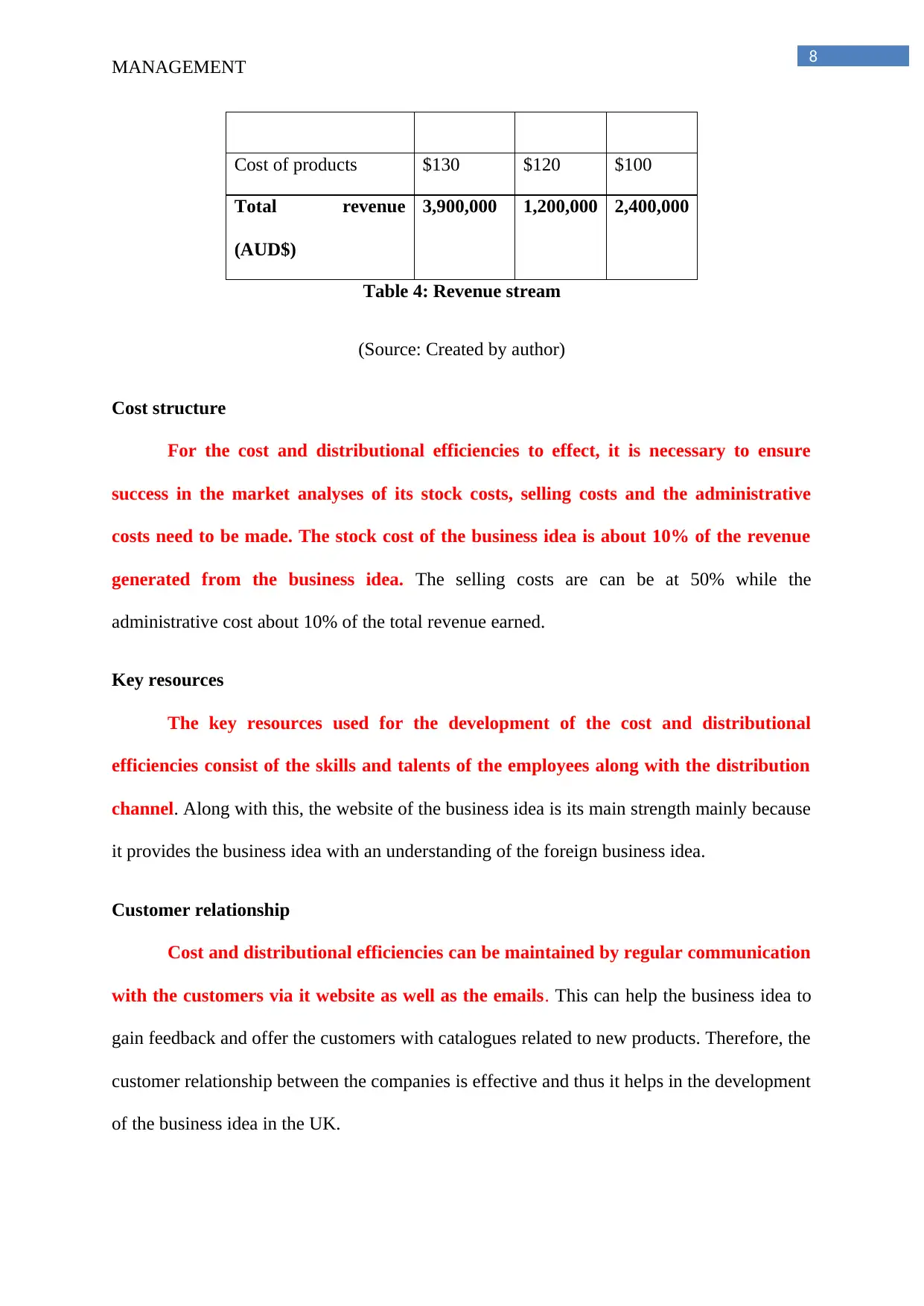
8
MANAGEMENT
Cost of products $130 $120 $100
Total revenue
(AUD$)
3,900,000 1,200,000 2,400,000
Table 4: Revenue stream
(Source: Created by author)
Cost structure
For the cost and distributional efficiencies to effect, it is necessary to ensure
success in the market analyses of its stock costs, selling costs and the administrative
costs need to be made. The stock cost of the business idea is about 10% of the revenue
generated from the business idea. The selling costs are can be at 50% while the
administrative cost about 10% of the total revenue earned.
Key resources
The key resources used for the development of the cost and distributional
efficiencies consist of the skills and talents of the employees along with the distribution
channel. Along with this, the website of the business idea is its main strength mainly because
it provides the business idea with an understanding of the foreign business idea.
Customer relationship
Cost and distributional efficiencies can be maintained by regular communication
with the customers via it website as well as the emails. This can help the business idea to
gain feedback and offer the customers with catalogues related to new products. Therefore, the
customer relationship between the companies is effective and thus it helps in the development
of the business idea in the UK.
MANAGEMENT
Cost of products $130 $120 $100
Total revenue
(AUD$)
3,900,000 1,200,000 2,400,000
Table 4: Revenue stream
(Source: Created by author)
Cost structure
For the cost and distributional efficiencies to effect, it is necessary to ensure
success in the market analyses of its stock costs, selling costs and the administrative
costs need to be made. The stock cost of the business idea is about 10% of the revenue
generated from the business idea. The selling costs are can be at 50% while the
administrative cost about 10% of the total revenue earned.
Key resources
The key resources used for the development of the cost and distributional
efficiencies consist of the skills and talents of the employees along with the distribution
channel. Along with this, the website of the business idea is its main strength mainly because
it provides the business idea with an understanding of the foreign business idea.
Customer relationship
Cost and distributional efficiencies can be maintained by regular communication
with the customers via it website as well as the emails. This can help the business idea to
gain feedback and offer the customers with catalogues related to new products. Therefore, the
customer relationship between the companies is effective and thus it helps in the development
of the business idea in the UK.
⊘ This is a preview!⊘
Do you want full access?
Subscribe today to unlock all pages.

Trusted by 1+ million students worldwide
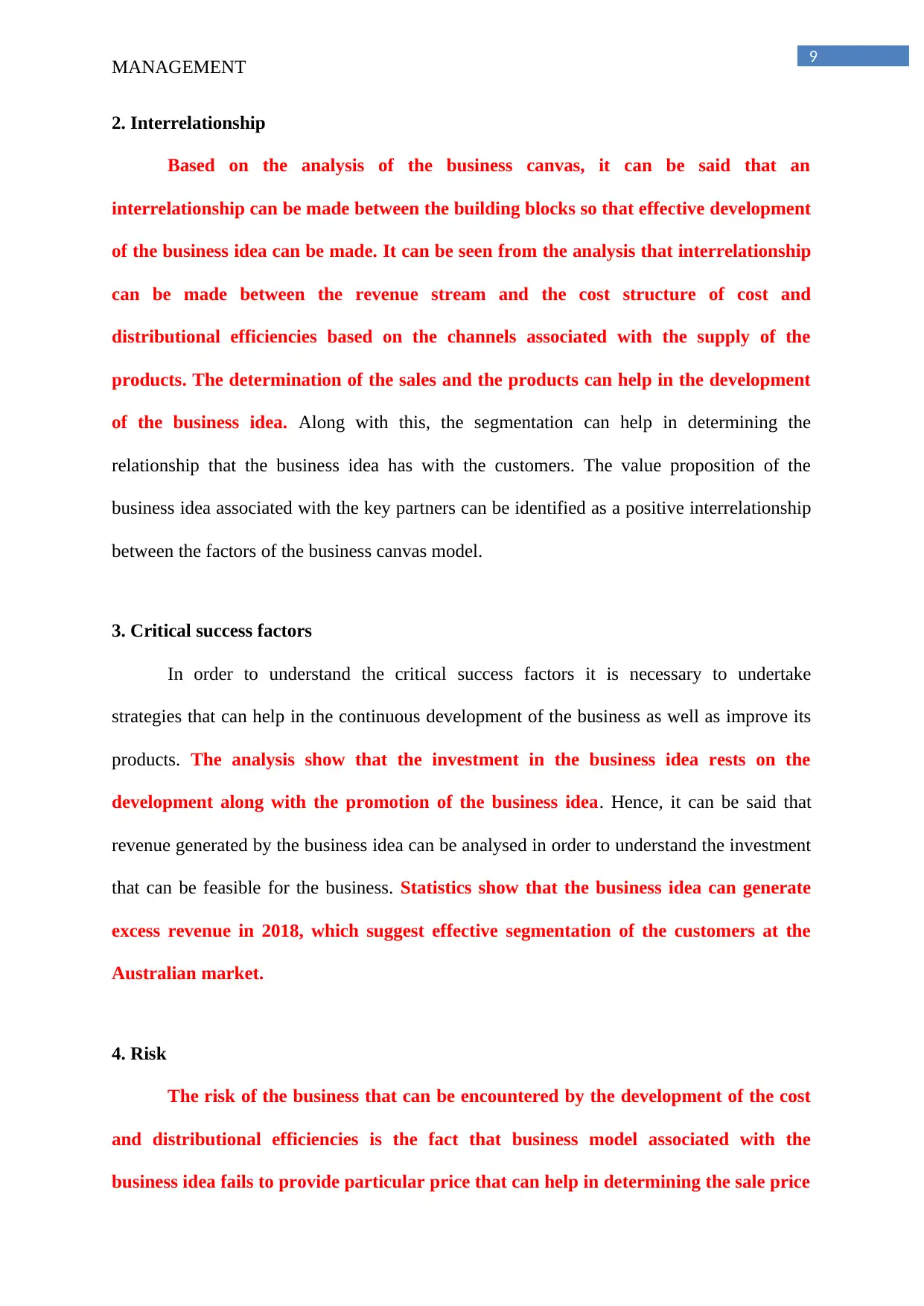
9
MANAGEMENT
2. Interrelationship
Based on the analysis of the business canvas, it can be said that an
interrelationship can be made between the building blocks so that effective development
of the business idea can be made. It can be seen from the analysis that interrelationship
can be made between the revenue stream and the cost structure of cost and
distributional efficiencies based on the channels associated with the supply of the
products. The determination of the sales and the products can help in the development
of the business idea. Along with this, the segmentation can help in determining the
relationship that the business idea has with the customers. The value proposition of the
business idea associated with the key partners can be identified as a positive interrelationship
between the factors of the business canvas model.
3. Critical success factors
In order to understand the critical success factors it is necessary to undertake
strategies that can help in the continuous development of the business as well as improve its
products. The analysis show that the investment in the business idea rests on the
development along with the promotion of the business idea. Hence, it can be said that
revenue generated by the business idea can be analysed in order to understand the investment
that can be feasible for the business. Statistics show that the business idea can generate
excess revenue in 2018, which suggest effective segmentation of the customers at the
Australian market.
4. Risk
The risk of the business that can be encountered by the development of the cost
and distributional efficiencies is the fact that business model associated with the
business idea fails to provide particular price that can help in determining the sale price
MANAGEMENT
2. Interrelationship
Based on the analysis of the business canvas, it can be said that an
interrelationship can be made between the building blocks so that effective development
of the business idea can be made. It can be seen from the analysis that interrelationship
can be made between the revenue stream and the cost structure of cost and
distributional efficiencies based on the channels associated with the supply of the
products. The determination of the sales and the products can help in the development
of the business idea. Along with this, the segmentation can help in determining the
relationship that the business idea has with the customers. The value proposition of the
business idea associated with the key partners can be identified as a positive interrelationship
between the factors of the business canvas model.
3. Critical success factors
In order to understand the critical success factors it is necessary to undertake
strategies that can help in the continuous development of the business as well as improve its
products. The analysis show that the investment in the business idea rests on the
development along with the promotion of the business idea. Hence, it can be said that
revenue generated by the business idea can be analysed in order to understand the investment
that can be feasible for the business. Statistics show that the business idea can generate
excess revenue in 2018, which suggest effective segmentation of the customers at the
Australian market.
4. Risk
The risk of the business that can be encountered by the development of the cost
and distributional efficiencies is the fact that business model associated with the
business idea fails to provide particular price that can help in determining the sale price
Paraphrase This Document
Need a fresh take? Get an instant paraphrase of this document with our AI Paraphraser
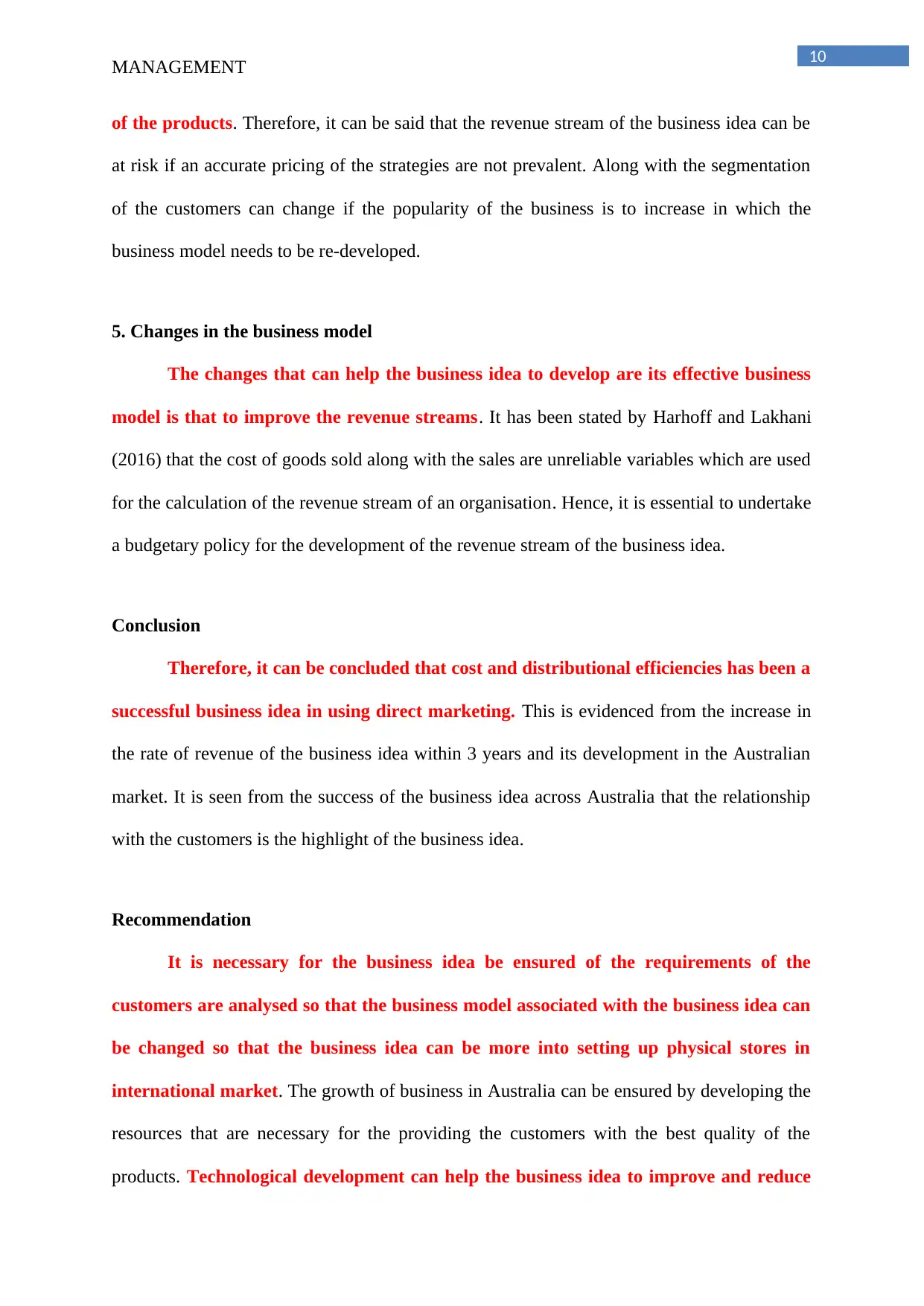
10
MANAGEMENT
of the products. Therefore, it can be said that the revenue stream of the business idea can be
at risk if an accurate pricing of the strategies are not prevalent. Along with the segmentation
of the customers can change if the popularity of the business is to increase in which the
business model needs to be re-developed.
5. Changes in the business model
The changes that can help the business idea to develop are its effective business
model is that to improve the revenue streams. It has been stated by Harhoff and Lakhani
(2016) that the cost of goods sold along with the sales are unreliable variables which are used
for the calculation of the revenue stream of an organisation. Hence, it is essential to undertake
a budgetary policy for the development of the revenue stream of the business idea.
Conclusion
Therefore, it can be concluded that cost and distributional efficiencies has been a
successful business idea in using direct marketing. This is evidenced from the increase in
the rate of revenue of the business idea within 3 years and its development in the Australian
market. It is seen from the success of the business idea across Australia that the relationship
with the customers is the highlight of the business idea.
Recommendation
It is necessary for the business idea be ensured of the requirements of the
customers are analysed so that the business model associated with the business idea can
be changed so that the business idea can be more into setting up physical stores in
international market. The growth of business in Australia can be ensured by developing the
resources that are necessary for the providing the customers with the best quality of the
products. Technological development can help the business idea to improve and reduce
MANAGEMENT
of the products. Therefore, it can be said that the revenue stream of the business idea can be
at risk if an accurate pricing of the strategies are not prevalent. Along with the segmentation
of the customers can change if the popularity of the business is to increase in which the
business model needs to be re-developed.
5. Changes in the business model
The changes that can help the business idea to develop are its effective business
model is that to improve the revenue streams. It has been stated by Harhoff and Lakhani
(2016) that the cost of goods sold along with the sales are unreliable variables which are used
for the calculation of the revenue stream of an organisation. Hence, it is essential to undertake
a budgetary policy for the development of the revenue stream of the business idea.
Conclusion
Therefore, it can be concluded that cost and distributional efficiencies has been a
successful business idea in using direct marketing. This is evidenced from the increase in
the rate of revenue of the business idea within 3 years and its development in the Australian
market. It is seen from the success of the business idea across Australia that the relationship
with the customers is the highlight of the business idea.
Recommendation
It is necessary for the business idea be ensured of the requirements of the
customers are analysed so that the business model associated with the business idea can
be changed so that the business idea can be more into setting up physical stores in
international market. The growth of business in Australia can be ensured by developing the
resources that are necessary for the providing the customers with the best quality of the
products. Technological development can help the business idea to improve and reduce

11
MANAGEMENT
the efforts of the labour and help in continuing with the growth in the Australian and
UK market.
MANAGEMENT
the efforts of the labour and help in continuing with the growth in the Australian and
UK market.
⊘ This is a preview!⊘
Do you want full access?
Subscribe today to unlock all pages.

Trusted by 1+ million students worldwide
1 out of 16
Related Documents
Your All-in-One AI-Powered Toolkit for Academic Success.
+13062052269
info@desklib.com
Available 24*7 on WhatsApp / Email
![[object Object]](/_next/static/media/star-bottom.7253800d.svg)
Unlock your academic potential
Copyright © 2020–2025 A2Z Services. All Rights Reserved. Developed and managed by ZUCOL.




